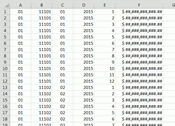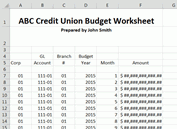Importing Budget Figures
| Screen ID: | UGLBGT6-1 | 
|
| Screen Title: | Import CU Budget | |
| Panel ID: | 5569 | |
| Tool Number: | 992 | |
| Click here to magnify |
This window appears after using “Upload” (F19) on the Choose Calculation Method screen.
This the first screen used to import data into your CU*BASE budget. This is the second part of a two-part process that involves first uploading the data from a PC file into the CU*BASE “GLIMPORT” file, then importing those records into your budget.
For complete instructions on importing data into your CU*BASE budget, refer to the Budgeting with CU*BASE booklet.
IMPORTANT: You can upload Income and Expense GLs ONLY. When uploading budget figures, amounts will be recorded as the “net change” for each G/L account (not resulting balance). Currently you can import budget figures for Income or Expense G/Ls only. Projected balances for your asset and liability G/Ls are not supported through the current upload process. This is because there is currently no way for the financial statements tools to report asset and liability balance projections in a balance sheet format. If any G/L accounts in the incoming file are an Asset or Liability type, they will appear as exceptions, similar to an invalid G/L account number. You’ll need to remove them from your original source file then try the upload and import again.
Choose a format and use Enter to proceed to the appropriate field setup window (Flat file, fixed-width file, or comma-delimited file). After you use Enter there, this window will reappear with a new Import File Data button enabled. Use that to complete the import process and proceed to the Budget Import Exceptions screen or the Budget Figures Calculated This Pass screen.
Supported File Types
Supported File Types include the following:
-
Flat file format – Not common, but might be an option available from your third-party vendor.
-
User-defined fixed file – Instead of a delimiter (separator between fields), the fields are padded to a fixed width.
-
User-defined comma-delimited format (also referred to as CSV or comma-separated values) – The most commonly used, this is the format typically created by spreadsheet program such as Microsoft© Excel.
All three formats must follow these rules for field type and length:
|
Field Name |
Type |
Total Length |
Decimals |
|
Corporation ID |
Numeric |
2 |
0 |
|
G/L Account # |
Numeric |
5 |
0 |
|
Branch/location |
Numeric |
2 |
0 |
|
Budget year |
Numeric |
4 |
0 |
|
Budget month |
Numeric |
2 (01 through 12) |
0 |
|
Amount* |
Numeric |
13 ($99,999,999,999.99) |
2 |
*IMPORTANT NOTE: This amount is recorded as the net change (field is actually Net Balance or NETBAL) per month for the G/L account, NOT the resulting balance.
Other requirements for each file type:
|
Type |
Field order | Extra fields allowed? | Notes |
|
Flat File Format |
Must be in the exact order as shown above |
No |
|
|
User-defined Fixed File Format |
Same fields as above but can be in any order in the file |
No |
|
|
User-defined Comma-Delimited Format |
Same fields as above but can be in any order in the file |
Yes, but must be to the right (after) the required fields, not between them |
(Otherwise the amounts will pull in as whole dollars in CU*BASE. If you create a file in Excel this will happen automatically, but be sure to alert your vendor so that this is applied correctly.) |
As a rule, worksheets you intend to convert and upload should not include other extraneous information such as column headings, blank rows, titles, graphics, or other special layout formatting. In other words,
|
This:
|
...not this:
|

